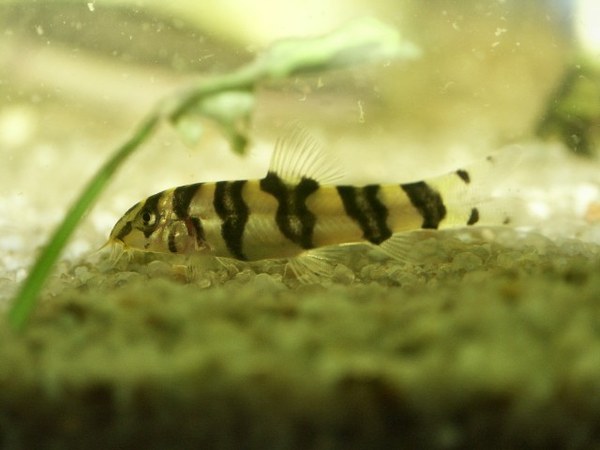Botia rostrata - Development of Markings During Growth

This article is a compilation of mainly two parts which formed a discussion of the species within the old Loaches Online Species Index. Printed pretty much as originally written with the authors credited and with nomenclature changes by Martin Thoene.
From: Bogdan Janiczak (boj@eti.pg.gda.pl)
Date: August
5th, 2002
First, I prepared earlier today a couple of photos of juvenile Botia rostrata specimens. I got them today in the morning from a local distributor.
These tiny beauties are approximately 1 inch long (not more than 3 cm at most) and are more or less similar in length to the juvenile Botia histrionica described in my earlier contribution some time ago. They appeared in good time to provide further reference data with respect to newly discovered Botia sp. aff. rostrata species.
I leave judgment and conclusions to the Loaches Online readers. What is worth pointing out, despite visible difference in bar patterns, is that juvenile Botia rostrata has plain transparent fins (contrary to both B. histrionica and Botia sp. aff. rostrata). Only the subtle black markings are hardly seen at the base of dorsal and anal fins. The pattern of markings on B. rostrata head is closer to that of Botia histrionica with a characteristic (though not so striking as in the case of B. histrionica) line running downwards from the fish eye. This line is practically absent in Botia sp. aff. rostrata species. I do hope that these little comments will provide further hints for better identification of deceptively similarly looking juvenile specimens of South-East Asian Botia species.
Sincerely,
Bogdan J. Janiczak
 |
 |
 |
 |
 |
From: Bogdan J. Janiczak (boj@pg.gda.pl)
Date: February 7th,
2003
This is a bit more extensive coverage of Botia rostrata species, that can be considered as second chapter of the original story started late 2002. I will try to minimize comments to the highest degree and let the photos speak instead.
Recently, while browsing briefly the Loaches Online discussion forum, I realized that there are still a lot of problems and confusion with respect to proper ID of Botia rostrata species. Below please find a set of photos showing a couple of fish from this species at different age and size. They well show the process of formation of typical, for this species, fin and body marking patterns. The juveniles shown half a year ago have all plain fins except the caudal. As the fish ages, they start to develop characteristic markings. From my personal observations adult B. rostrata typically has a set of four twin-markers on the caudal fin, while younger specimens, have the number of twin markers correlated with their age and maturity. Of course, it's a kind of statistical averaging, because of the varying maturation rate of individual specimens (even within the same school). That means that exceptions from the rule are likely to exist. Adult fish (as the female shown in one of the attached photos) can reach a total length slightly exceeding 10cm; males are usually a bit smaller and more slender. But, even a full grown Botia rostrata, when compared to closely related species of Botia histrionica, may initially appear as a much younger brother (see photo). I do believe my comments will provide further hints for people having problems with Botia rostrata ID.
Regards from Poland,
Bogdan J. Janiczak
 |
 |
| A six month old B. rostrata will usually have a set of 2 twin markers on caudal fin and a typical length of 5cm (TL). (photos above) |
 |
| The picture above shows a 10-month old specimen. Markings on pelvic and dorsal fins, however, are still not fully developed. Shape of dark vertical and horizontal stripes as well as distribution and number of bright oval reticulae are also in the phase of construction. The latter will require much more time to appear in abundance. |
 |
| A one year old specimen (above), in majority of cases, usually already posses adult caudal fin marking pattern and is within the range of 6-7cm TL. However, one can occasionally find enormously reticulated one year old specimens. |
Document Actions

